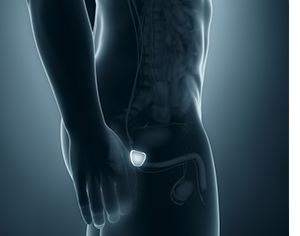
Prostatectomy includes a number of surgical procedures to remove part or all of the prostate gland. The prostate gland is situated in the male pelvis, below the urinary bladder. It surrounds the urethra, which carries urine from the bladder to the penis.
Radical prostatectomy is an operation to remove the prostate gland and the tissues surrounding the prostate gland. This usually includes the seminal vesicles and some nearby lymph nodes. Radical prostatectomy can cure prostate cancer in men whose cancer is limited to the prostate.
Eligibility for Radical Prostatectomy
Men younger than the age of 75 with very limited prostate cancer and are expected to live at least 10 more years are eligible to undergo radical prostatectomy.
Before performing radical prostatectomy, it is important to note that prostate cancer has not spread beyond the prostate. The risk of the spread of cancer can be determined from tables comparing the results of a biopsy and PSA levels, apart from CT scans, bone scans, MRI scans, and ultrasound. However, before opting for surgery, other options may also be considered depending upon the extent of spread that includes radiation therapy, hormone therapy, or simply observing the prostate cancer over time, since many prostate cancers grow slowly.
Types of Radical Prostatectomy
Surgeons choose from two different approaches to reach and remove the prostate during radical prostatectomy. There are three types of Radical Prostatectomy: Open prostatectomy, Laparoscopic prostatectomy, and Robot-assisted laparoscopic prostatectomy.
Open Prostatectomy
In this surgical method of radical prostatectomy, the surgeon makes a vertical inch, for most patients, the incision is 4 to 5 inches long but may also vary from 8- to 10-inch incision depending upon the severity and is performed beneath the belly button. Radical prostatectomy is performed through this incision. In rare cases, the incision is made in the perineum, the space between the scrotum and anus.
The open procedure’s longer incision results in a slightly longer recovery time which is about 6 weeks.
Laparoscopic prostatectomy
In laparoscopic prostatectomy, surgeons start by making several small incisions across the belly. Surgical tools and a camera are inserted through the incisions, and radical prostatectomy is performed by viewing the entire operation on a video screen.
Although this surgery takes approximately 3 hours to perform, patients generally feel much better and have significantly less pain in the early operative period. Unlike open surgery where the catheter stays in for two to three weeks, most laparoscopic prostatectomy patients have their Foley catheters removed on the third day after surgery.
Robot-assisted laparoscopic prostatectomy
Small incisions are made in the belly, as in regular laparoscopic prostatectomy. A surgeon controls an advanced robotic system of surgical tools from outside the body. A high-tech interface lets the surgeon use natural wrist movements and a 3-D screen during radical prostatectomy. Using the advanced surgical system, miniaturized robotic instruments are passed through several small keyhole incisions in the patient’s abdomen to allow the surgeon to remove the prostate and also nearby tissues with great precision. This is much less invasive than a conventional radical retropubic prostatectomy, which involves an abdominal incision that extends from the belly button to the pubic bone.
How long does the operation take?
Surgery usually lasts three to four hours. However, from the time you leave the pre-op area until you arrive in the recovery room, it takes five to six hours.
How long will the patient be in the recovery room after surgery?
Not more than two hours.
Will I need to be in the Intensive Care Unit (ICU)?
Rarely patients need to go to the ICU after routine prostate surgery depending upon the condition.
What are the potential complications of this surgery?
All surgical procedures have inherent risks and the potential complications may include bleeding, infection, incontinence or loss of urinary control and blood clots.
What can I do before surgery to be optimally prepared?
It is important to refrain from aspirin or aspirin-like compounds for at least one week before surgery and the day before the operation, you may be instructed to begin a liquid diet.
What will be the recovery time after Surgery?
Most people recover quite rapidly from their prostate surgery and begin working after only a few days or weeks. The recovery time will also depend upon the type of surgery such as for six weeks after open prostatectomy, and for two to three weeks after laparoscopic prostate surgery.
What precautions are needed during recovery?
During the recovery period, you should refrain from vigorous exercise and lift no more than ten pounds at a time. Driving should also be avoided while the catheter is in place.
Types of Radical Prostatectomy
Surgeons choose from two different approaches to reach and remove the prostate during radical prostatectomy. There are three types of Radical Prostatectomy: Open prostatectomy, Laparoscopic prostatectomy, and Robot-assisted laparoscopic prostatectomy.
Open Prostatectomy
In this surgical method of radical prostatectomy, the surgeon makes a vertical inch, for most patients, the incision is 4 to 5 inches long but may also vary from 8- to 10-inch incision depending upon the severity and is performed beneath the belly button. Radical prostatectomy is performed through this incision. In rare cases, the incision is made in the perineum, the space between the scrotum and anus.
The open procedure’s longer incision results in a slightly longer recovery time which is about 6 weeks.
Laparoscopic prostatectomy
In laparoscopic prostatectomy, surgeons start by making several small incisions across the belly. Surgical tools and a camera are inserted through the incisions, and radical prostatectomy is performed by viewing the entire operation on a video screen.
Although this surgery takes approximately 3 hours to perform, patients generally feel much better and have significantly less pain in the early operative period. Unlike open surgery where the catheter stays in for two to three weeks, most laparoscopic prostatectomy patients have their Foley catheters removed on the third day after surgery.
Robot-assisted laparoscopic prostatectomy
Small incisions are made in the belly, as in regular laparoscopic prostatectomy. A surgeon controls an advanced robotic system of surgical tools from outside the body. A high-tech interface lets the surgeon use natural wrist movements and a 3-D screen during radical prostatectomy. Using the advanced surgical system, miniaturized robotic instruments are passed through several small keyhole incisions in the patient’s abdomen to allow the surgeon to remove the prostate and also nearby tissues with great precision. This is much less invasive than a conventional radical retropubic prostatectomy, which involves an abdominal incision that extends from the belly button to the pubic bone.
How long does the operation take?
Surgery usually lasts three to four hours. However, from the time you leave the pre-op area until you arrive in the recovery room, it takes five to six hours.
How long will the patient be in the recovery room after surgery?
Not more than two hours.
Will I need to be in the Intensive Care Unit (ICU)?
Rarely patients need to go to the ICU after routine prostate surgery depending upon the condition.
What are the potential complications of this surgery?
All surgical procedures have inherent risks and the potential complications may include bleeding, infection, incontinence or loss of urinary control and blood clots.
What can I do before surgery to be optimally prepared?
It is important to refrain from aspirin or aspirin-like compounds for at least one week before surgery and the day before the operation, you may be instructed to begin a liquid diet.
What will be the recovery time after Surgery?
Most people recover quite rapidly from their prostate surgery and begin working after only a few days or weeks. The recovery time will also depend upon the type of surgery such as for six weeks after open prostatectomy, and for two to three weeks after laparoscopic prostate surgery.
What precautions are needed during recovery?
During the recovery period, you should refrain from vigorous exercise and lift no more than ten pounds at a time. Driving should also be avoided while the catheter is in place.

Rating :


With over 10 years for being in operations this hospital enjoys its location in South Delhi overseeing the huge green belt extending from hospital till the QutabMinar comp.....

Rating :
Dr. Kalia is taking steps to ensure that all the pros and cons of hair transplant are put forward to the patient that enable him or her to make the correct decision. The patient friendly approach of Dr. Kalia is bringing a revolution i.....

Rating :
Manipal Hospital Whitefield (MHW) is a unit of the renowned Manipal Hospitals network that is known for Quality and Patient care. It is a 280 beds multi-specialty Hospital offering world class services in .....

Rating :



Rating :
Located in the National Capital Region of New Delhi - Aligarh, Varun Trauma & Burn Centre (P) Ltd., a unit of Varun Hospital a Super-Specialty Hospital, is just a 10 minute drive from Aligarh's Railway Station & Bus Stop. Our facility is verified as a L.....

Rating :

Our experts have treated 5 lakh+ patients across 25+ specialties like Cardiac Sciences, Minimal Access and Laparoscopic Surgery, Neurosciences, Urology, Orthopedics, Aesthetics and Reconstructive Surgery and Nephrology. We are a 74 bed.....

Rating :
In the year 1998, Dr. Sunil Chandra Bagchi and Dr. Ratish Ch. Paul founded Susrut Eye Foundation & Research Centre with a motto to eradicate blindness and make this world a beautiful place to those who are still in darkness. They r.....

Rating :
India’s large and diverse population warrants an efficient health care infrastructure that should be accessible to all strata’s of society. Good quality health care should not be a privilege of the elite only. Metro Group.....

Rating :

Rating :
Hospital Profile Description Currently Not Available

Prostatectomy includes a number of surgical procedures to remove part or all of the prostate gland. The prostate gland is situated in the male pelvis, below the urinary bladder. It surrounds the urethra, which carries urine from the bladder to the penis.
Radical prostatectomy is an operation to remove the prostate gland and the tissues surrounding the prostate gland. This usually includes the seminal vesicles and some nearby lymph nodes. Radical prostatectomy can cure prostate cancer in men whose cancer is limited to the prostate.
Eligibility for Radical Prostatectomy
Men younger than the age of 75 with very limited prostate cancer and are expected to live at least 10 more years are eligible to undergo radical prostatectomy.
Before performing radical prostatectomy, it is important to note that prostate cancer has not spread beyond the prostate. The risk of the spread of cancer can be determined from tables comparing the results of a biopsy and PSA levels, apart from CT scans, bone scans, MRI scans, and ultrasound. However, before opting for surgery, other options may also be considered depending upon the extent of spread that includes radiation therapy, hormone therapy, or simply observing the prostate cancer over time, since many prostate cancers grow slowly.
Types of Radical Prostatectomy
Surgeons choose from two different approaches to reach and remove the prostate during radical prostatectomy. There are three types of Radical Prostatectomy: Open prostatectomy, Laparoscopic prostatectomy, and Robot-assisted laparoscopic prostatectomy.
Open Prostatectomy
In this surgical method of radical prostatectomy, the surgeon makes a vertical inch, for most patients, the incision is 4 to 5 inches long but may also vary from 8- to 10-inch incision depending upon the severity and is performed beneath the belly button. Radical prostatectomy is performed through this incision. In rare cases, the incision is made in the perineum, the space between the scrotum and anus.
The open procedure’s longer incision results in a slightly longer recovery time which is about 6 weeks.
Laparoscopic prostatectomy
In laparoscopic prostatectomy, surgeons start by making several small incisions across the belly. Surgical tools and a camera are inserted through the incisions, and radical prostatectomy is performed by viewing the entire operation on a video screen.
Although this surgery takes approximately 3 hours to perform, patients generally feel much better and have significantly less pain in the early operative period. Unlike open surgery where the catheter stays in for two to three weeks, most laparoscopic prostatectomy patients have their Foley catheters removed on the third day after surgery.
Robot-assisted laparoscopic prostatectomy
Small incisions are made in the belly, as in regular laparoscopic prostatectomy. A surgeon controls an advanced robotic system of surgical tools from outside the body. A high-tech interface lets the surgeon use natural wrist movements and a 3-D screen during radical prostatectomy. Using the advanced surgical system, miniaturized robotic instruments are passed through several small keyhole incisions in the patient’s abdomen to allow the surgeon to remove the prostate and also nearby tissues with great precision. This is much less invasive than a conventional radical retropubic prostatectomy, which involves an abdominal incision that extends from the belly button to the pubic bone.
How long does the operation take?
Surgery usually lasts three to four hours. However, from the time you leave the pre-op area until you arrive in the recovery room, it takes five to six hours.
How long will the patient be in the recovery room after surgery?
Not more than two hours.
Will I need to be in the Intensive Care Unit (ICU)?
Rarely patients need to go to the ICU after routine prostate surgery depending upon the condition.
What are the potential complications of this surgery?
All surgical procedures have inherent risks and the potential complications may include bleeding, infection, incontinence or loss of urinary control and blood clots.
What can I do before surgery to be optimally prepared?
It is important to refrain from aspirin or aspirin-like compounds for at least one week before surgery and the day before the operation, you may be instructed to begin a liquid diet.
What will be the recovery time after Surgery?
Most people recover quite rapidly from their prostate surgery and begin working after only a few days or weeks. The recovery time will also depend upon the type of surgery such as for six weeks after open prostatectomy, and for two to three weeks after laparoscopic prostate surgery.
What precautions are needed during recovery?
During the recovery period, you should refrain from vigorous exercise and lift no more than ten pounds at a time. Driving should also be avoided while the catheter is in place.

Rating :


With over 10 years for being in operations this hospital enjoys its location in South Delhi overseeing the huge green belt extending from hospital till the QutabMinar comp.....

Rating :
Dr. Kalia is taking steps to ensure that all the pros and cons of hair transplant are put forward to the patient that enable him or her to make the correct decision. The patient friendly approach of Dr. Kalia is bringing a revolution i.....

Rating :
Manipal Hospital Whitefield (MHW) is a unit of the renowned Manipal Hospitals network that is known for Quality and Patient care. It is a 280 beds multi-specialty Hospital offering world class services in .....

Rating :



Rating :
Located in the National Capital Region of New Delhi - Aligarh, Varun Trauma & Burn Centre (P) Ltd., a unit of Varun Hospital a Super-Specialty Hospital, is just a 10 minute drive from Aligarh's Railway Station & Bus Stop. Our facility is verified as a L.....

Rating :

Our experts have treated 5 lakh+ patients across 25+ specialties like Cardiac Sciences, Minimal Access and Laparoscopic Surgery, Neurosciences, Urology, Orthopedics, Aesthetics and Reconstructive Surgery and Nephrology. We are a 74 bed.....

Rating :
In the year 1998, Dr. Sunil Chandra Bagchi and Dr. Ratish Ch. Paul founded Susrut Eye Foundation & Research Centre with a motto to eradicate blindness and make this world a beautiful place to those who are still in darkness. They r.....

Rating :
India’s large and diverse population warrants an efficient health care infrastructure that should be accessible to all strata’s of society. Good quality health care should not be a privilege of the elite only. Metro Group.....

Rating :

Rating :
Hospital Profile Description Currently Not Available
Not Available
Medtravels ensures bridging the gap and providing accessibility for patients to interact directly with healthcare service providers. We remain committed to connecting all stakeholders across geographies, and focusing on taking Healthcare beyond boundaries.

We are one of the first few organizations in India to be NABH certified. This itself speaks out loud about the services and facilities we provide to our clients while ensuring optimum quality at all aspects.

We ensure to bring you the best in terms of both healthcare quality & affordability. We value our customers so providing the best of services to them at an affordable price is our objective.

We understand that getting the first opinion is the most crucial step towards your healthcare journey and so based on your reports, we provide you consultation(s) or opinion(s) from top-notch doctors & consultants without any charges.

Travelling outside your home country can be a rigorous affair. So, here we are, to guide you through all the necessities such as – Medical Visa, Air Bookings, Accommodation, Air Ambulance, Pharmacy, Medical Loan, Leisure Travel.

We constantly strive to provide our clients with maximum options and so we have global coverage in terms of Healthcare Providers. We provide you hospital options from – INDIA, SINGAPORE, THAILAND, MALAYSIA, TURKEY & the list goes on

Our objective is to work with complete transparency with both our partners & clients. With this motto, we maintain not to charge you for anything. When you come for treatment, you pay the hospital directly.
Not Available